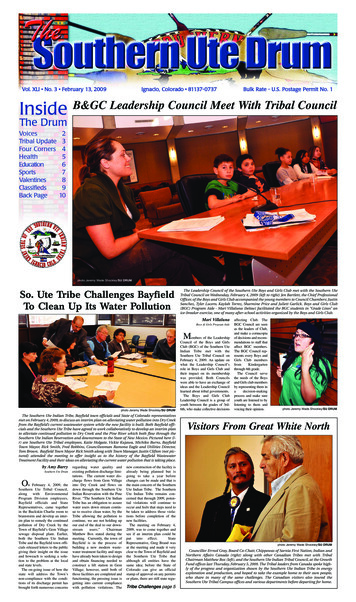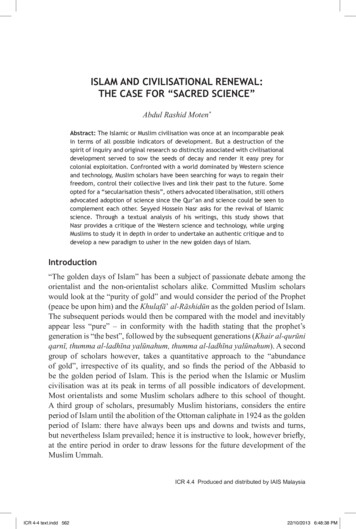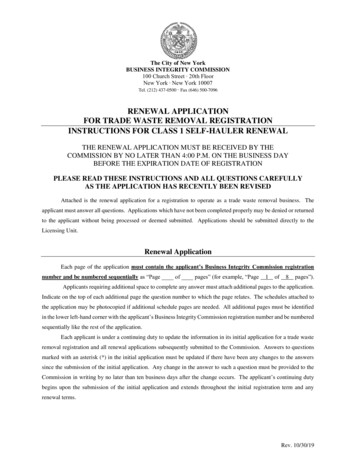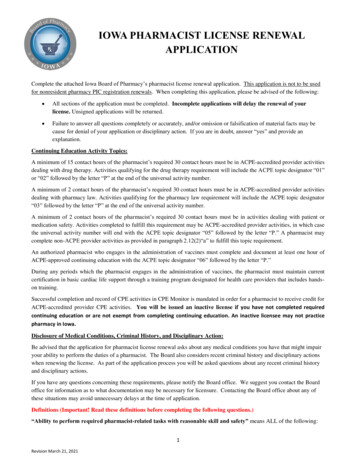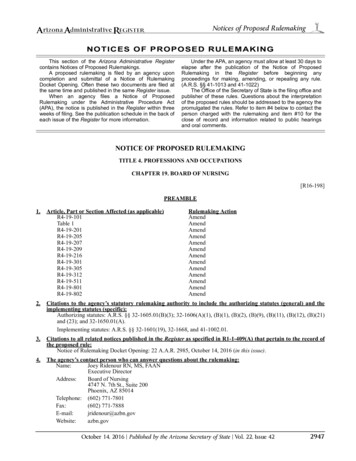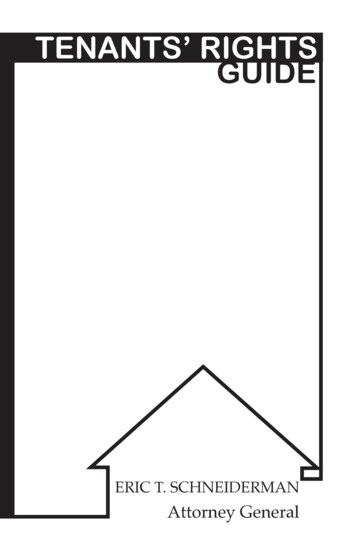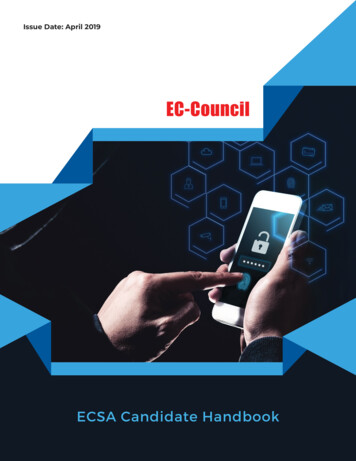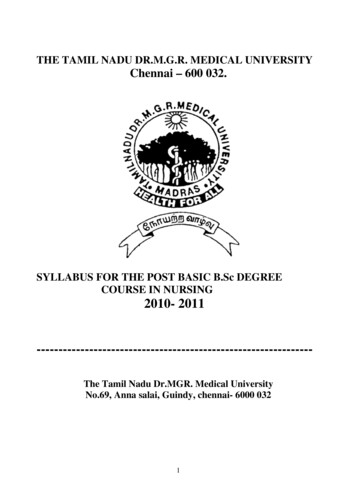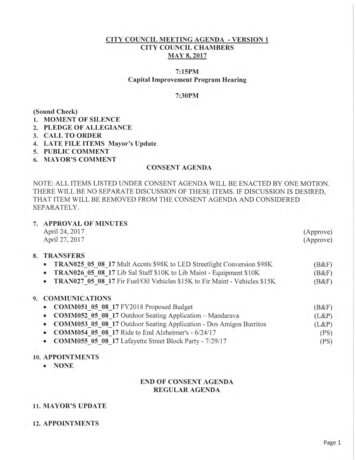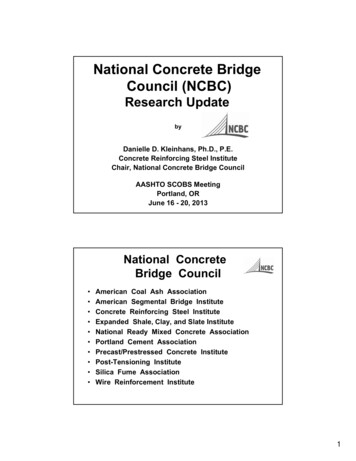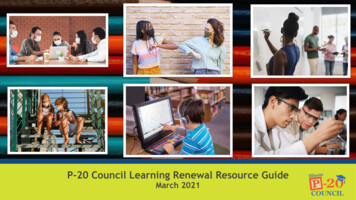
Transcription
P-20 Council Learning Renewal Resource GuideMarch 2021
Introduction P-20 Learning Renewal Resource GuideDear readers of this guide,On behalf of the P-20 Council, we welcome you to the Learning Renewal Resource Guide, a collaborative, living document that highlights a set of opportunities to invest inlearning renewal and support our students, educators and broader community in these unprecedented times.COVID-19 has had significant impact on our students and educators that calls for immediate and thoughtful action. The abrupt shutdown of in-person school has led tomeasurable learning losses and social-emotional needs have increased due to the economic slowdown, social isolation and the threat of the virus itself, with a disproportionatetoll on students of color and students with higher needs. Practitioners, caretakers and organizations have faced exhaustion from heroic efforts to serve their communities.As we look ahead to addressing these near-term challenges and ways to build toward a better future, it will be critical to take a step back and dedicate thoughtful planning tohow we can drive learning renewal. Our hope is that this guide can be used to help inform that planning, particularly as it relates to federal relief spending decisions.This guide is not meant to be directive or read cover to cover, but informational and help quickly navigate to strategies that can be most impactful in your context. It offersimplementation guidance and resources regarding academic, social emotional and mental health supports for P-postsecondary students and teachers, faculty and staff. It aimsto help enable local leaders to make informed decisions and implementation plans at the pace necessary to address the needs of their communities. It also serves to inspireengagement and input in those spending decisions from those most impacted. Recognizing there will be no one-size-fits-all solution, it will be critical to include the voices ofpractitioners, students, caregivers, and community organizations in the learning renewal planning process to understand how to best serve our communities.The creation of this guide has been a collaborative effort, that will continue to rely on input of those most impacted. Its content reflects evidence-based research grounded inthe Illinois context, insights from focus groups, and learnings from the many impactful steps that have already been taken to support our students. We hope you will find thisinformation useful to your communities, and we implore you to help us refine and add to this document over time. All input can be directed to iledrenewal@gmail.com orsubmitted through this survey.Thank you,Deputy Governor Jesse Ruiz and the P-20 Council Learning Renewal Co-chairsJesse RuizDeputy Governorfor EducationDr. Carmen I. AyalaState Superintendentof Education, ISBEDr. Brian DurhamDr. Jamilah R. Jor'dan Dr. Ernesto MatiasExecutive Director, Executive Director,Chief EducationICCBGOECDOfficer, ISBEGinger OstroExecutive Director,IBHERobin SteansBeth Swanson,President, Advance CEO, A BetterIllinoisChicagoEric ZarnikowExecutive Director,ISAC2
Before diving in Consider the 3-5 biggestchallenges facing yourlocal education system*The following pages contain an immense amount ofinformation and resources that are not meant to beread cover to coverFocus on the chapters that align with your priority areas* See introduction for guiding questions and ways to solicit input from your community3
Table of Contents P-20 Learning Renewal Resource GuideContentIntroductionPage #05Context, purpose and how to use this guide09Key contributors and who this guide is for10What this guide offers and key questions to consider14'Road to Renewal' vision and chapter summary15IL Road to Renewal – Vision to guide short and long-term actions towards learning renewal1612 priority topic areas to inform spending decisions along the Road to Renewal17Featured initiatives to drive Learning RenewalLearning Renewal Resource Guide: Deep dives on 12 priority topic areas19, 20, 2123Chapter 1: Support enrollment, retention, and re-engagement with communication initiatives for academic progression24Chapter 2: Build individualized student fact base with academic and behavioral diagnostics and progress monitoring36Chapter 3: Reimagine the school calendar and expand the school day / year49Chapter 4: Provide out of classroom learning experiences through tutoring, before/after school, summer camps, etc.60Chapter 5: Connect districts/institutions with community organizations that connect students to comprehensive support75Chapter 6: Enhance accessibility of academic and behavioral counseling resources, especially for at-promise students85Chapter 7: Mental wellness and trauma-informed, culturally responsive schools99Chapter 8: Evaluate and improve hybrid/remote learning models to develop long-term digital strategic priorities120Chapter 9: Improve quality of learning through altered classroom structures, educator P.D., and digital tools133Chapter 10: Increase flexibility of secondary, post-secondary environment to accommodate for other responsibilities147Chapter 11: Support students with structured engagement in transition periods161Chapter 12: Enable work-based career development experiences and career placement services1714
P-20 Learning RenewalResource Guide Introduction5
An unprecedented time ineducation and a unique opportunityto invest in a better futureCOVID-19 has significantly impacted the ILeducation system, and has exacerbated racialand socioeconomic inequitiesStudents have had fewer opportunities to learnand have suffered through severe challenges totheir wellbeing, while educators, personnel,administrators and caregivers have facedexhaustion from heroic efforts to serve studentsTo address the pandemic's negative impacts,federal dollars have been allocated toeducation, the majority of which will flowdirectly to districts and higher ed institutionsWe now have a window ofopportunity to take a step back,and dedicate focused attentionto investing in learning renewal6
The P-20 Resource Guide is a collaborativedocument that details a set of opportunitiesto invest in learning renewalThis guide is meant to be informational, not directive, and inspireactions that will drive learning renewalThe P-20Learning RenewalResource GuideThe detail within this guide is meant to help inform spendingdecisions of not only new federal dollars, but also existing fundingthat will continue in the longer term and future federal aidThis content has been developed by administrators, educators/staff,agencies, students and caretakers to showcase the universe ofpotential actions, and will continue to rely on continuous input andadvocacy from those most impacted to help it evolve over timeIt is only one part of the broader collaborative effort that thisunprecedented time calls for, and ultimately aims to help build anetwork of people and resources dedicated to learning renewal7
Start by reviewing chapter topics: Work with all localstakeholders to identify 3-5 priority areas that are mostrelevant to your needs and the populations you serve - We donot recommend reading the guide cover to cover!How to usethis guideFocus on a few key initiatives: Each will take time and focus toexecute well. Planning and implementation cannot be rushed,and it is not possible to do it all. In parallel, there is also aneed to revisit fundamentals (e.g., realignment of curriculum)Meet with your team to review priority initiatives:Encourage everyone to read the introduction and relevantchapters/initiatives prior to the meeting. Assume 30 minutesper priority areaLeverage case studies, implementation guidance & sources:Use this guide to further understand how initiatives could bedeployed in your community – Please feel comfortablereaching out to leaders of the resources providedProvide feedback and contribute additional content: Submitany additional sources, case studies, etc. to the guide throughthis survey and focus groups8
Guidance maintains a strong equity focus Initiative details include equity considerations for underserved populationsto ensure equal opportunity to all students by serving their individual needsThe guide is living and evolving Guide to be reviewed and updated by P-20 Council as the landscape evolves Continuous feedback and input will be critical to the usefulness of the guide(Link to feedback survey), and focus groups (Sign up for focus groups here)Coreprinciples ofthis guideContent is informed by those most impacted Chapter topic areas derived from robust prioritization by P-20 Councilworking teams which represented over 50 agencies and organizations Details within the guide reflect input from focus groups with agencies,educators/staff, administrators, caregivers and students As users consider ways to deploy federal aid, they should seek input fromlocal stakeholders to identify specific needs of communityThere is no 'one-size-fits-all' approach Despite the same end goal, the journey will look different for everyone Users of the guide must make decisions relevant to their community,particularly those most impacted by racial/socioeconomic inequities Guide does not assume many of these initiatives are not already being donebut rather details priority areas for new or further investmentInitiatives are aligned with broader state goals Content built with state education agency strategic goals in mind Topic areas have near-term and long-term solutions to position IL on the'Road to Renewal' and transformative change9
Contributors to this guide (non-exhaustive)Don't see your logo? Please contact us at iledrenewal@gmail.comThe above organizations participated in the development of this guide through working teams, focusgroups and informal feedback.10
Voices and perspectives from 300 educators, students and administratorsacross the state have been incorporated into resource ited internetaccessCaregiversEx. perspectiverepresentedJuvenile detentioncenter : Focus groups provided a diverse set of voices,though they may not be completely representative ofperspectives throughout the entire state.If you are interested in gathering input from your localteachers, educators, staff, etc., we have resources tohelp! Please contact us at iledrenewal@gmail.com.Focus group volunteers: 255 total educators (220 from Teach Plus surveys and focus groups, additional 2 early childhood, 30 K-12, 6 higher education fromP-20 focus groups); 11 total students (7 K-12, 4 higher education); 37 total administrators (28 PK-12, 9 higher education); 17 total caregivers11
Many intended users for this guideUsers of theguideExamplesUse of /contributionto guideGovernmentLocal leaders ineducationFamilies andstudentsEducatorsSchools andinstitutionsCommunityOrganizationsAgencies, cabinets,law idents/Chancellors ofhigher ed,principals, trustees,county boardsPTAs, individualcaretakers andstudentsProfessors, teachers,IFT, IEA, localteachers' es, localfaith/health/recreation orgsTo inform fundingallocation/ policydecisionsTo inform funddeployment decisionsat local levelTo further understand and advocate for ways tosupport learning renewal and inspire engagement andinput in funding decisionsTo provide guidance/feedback for updates to the guide12
Chapter contentsThe guide consists of chapters detailing 12 priority topic areas and underlyinginitiatives to consider deploying for learning renewalChapter summaryCost and impactestimates*Focus group quotesImplementationguidance*Case study examplesRelevant resources**Throughout chapters, please note that vendors have not been vetted, approved or endorsed by the state, they are included as example resourcesKey risks &mitigation strategies13
What do the data and voices of those most impacted tell us about theneeds of our students, caregivers and educators? What existing initiatives have driven meaningful impact in our community?Is there an opportunity to scale? What might implementation and necessary resources for initiatives looklike beyond the 1-2 year federal aid timeline?Consider a set ofdiscussion questionswhile navigating thechapters What might the unintended consequences of implementation be,particularly regarding racial and socioeconomic inequity? Which orgs could serve as valuable partners in implementation of theseinitiatives? What resources do we need / have access to? How can we ensure we are not overburdening faculty, staff, student andfamily workloads / stress levels? How can we ensure that the input of students, families, unions and thefaculty and staff are part of the planning and decision-making process? How do these initiatives address student needs equitably? How will we ensure our decision-making is humanizing, trauma-informed,and culturally responsive? In what ways can we utilize these funds to build on ourdistrict/institution/community strengths?14
IL 'Road to Renewal' visionand Chapter Summary15
Best-in-class hybrid &digital learning modelsAcademic advising &supportIL Education vision for the'Road to Renewal'Connect educatorpreparation programs withstudents to provide highimpact tutoring*Not exhaustiveImplement digital bestpractices to increaseparticipation and leveragedigital tools for in-personlearningModify course schedulingand required course loadsto allow flexibility forstudentsTransitional period &workforce supportWellness & emotionalsupportEnrollment &re-engagementComprehensivediagnostic systemExtended time forlearning & supportDeploy tracking andtargeted (re)engagementcommunication programsfor Pre-K, K, and "lost"students & theircaregivers across the P20spectrumProvide comprehensiveacademic & behavioralscreening systemExtend the school day and/oradd days to the school calendarDevelop tools to proposemulti-tiered approach totailor student supportInvest in community org. afterschool resourcing & summerprogrammingScale trauma-informedpartnerships (e.g., LurieChildren's) to provide criticalmental health supporttrainings to more educatorsReach a specific ratio ofcounselors : students forboth behavioral andacademic counselingProvide structuredresources (e.g., academic/behavioral counselors) tosupport students andcaregivers through criticaltransition periodsEstablish a non-creditprogram that identifiescross-state employmentopportunities and connectsstudents to employersExecution of each step in the vision not required but serves as guide or example of how districts can embrace the learning renewal process. Each step doesn't have tobe addressed linearly, not all steps need to be addressed, and steps should be selected and modified based on district/institution context and needs16
Resource GuideChapters12 priority topicareas to informspending decisionsalong the 'Road toRenewal' vision1Support enrollment, retention, andre-engagement initiatives to ensureacademic progression across P-20spectrum2Build individualized student factbase with academic and behavioraldiagnostics and progress monitoring7Invest in infrastructure for mentalwellness and trauma-informed,culturally responsive schools,including educator P.D. and support8Evaluate and improvehybrid/remote learning models todevelop long-term digital strategicprioritiesImprove quality of learning throughaltered classroom structures,educator professional development,and digital tools3Reimagine school calendar andexpand school day / year94Provide out-of-classroom learningexperiences through tutoring, afterschool, summer camps, etc.Increase flexibility of secondary,post-secondary environment to10accommodate for otherresponsibilities5Connect districts/institutions withcommunity organizations thatconnect students to comprehensivesupportSupport students with structuredengagement and enhanced11communications in transitionperiods6Enhance accessibility of academic &behavioral counseling resources,especially for at-promise students(including year-round support)Design an integrated education/workforce strategy and playbook12and offer work-driven creditopportunities17
Schools and institutions are already implementing innovative practices across IL*Please provide additional case study examples from your school/institution. Email iledrenewal@gmail.com for more information21 Targeted Student Retention Strategies 6 12 Sauk Valley CC, Lee CountyDeveloped a model to ID summer dropout risksand target them for retention effortsCalled de-matriculated students to motivate toreregisterBolstered IT and guaranteed laptop accessTelemental HealthLincoln Land CC, Sangamon CountyPartnership with Talkspace to providetelemental health counseling for all students1 session/month free, add'l at reduced rateSchool-wide Dual Credit ProgramVienna HS, Johnson CountyAll students take a placement test to placeinto regular or dual enrollment45% of students are in dual credit courses (10%IL avg.) and 3% are in remedial (44% IL avg.);student body is 49% low-income (28% IL avg.) 5 10 KIDS for Kindergarten ReadinessDeKalb CountyKIDS assessment determines young children'sKindergarten readinessGrant for educators creating toolkits forlearning experiences that improve readinessCommunity program informing parents on keynurturing practices for pre-K childrenKuumba Lynx Arts PartnershipUplift Community HS, Cook CountyKuumba Lynx (KL) is a non-profit urban artsyouth development program based out of UpliftCommunity HSIntegrates arts education with a restorativejustice lens into curriculumStudent Financial AssistanceEastern Illinois University, Coles CountyEIU assembled a group of faculty, staff, andadministrators charged with identifying needand directing assistance to minority, firstgeneration, and low-income students 250K of GEER funding was allocated to relieveoutstanding balances for 237 students# Chapter # - see chapter for additional case study detailPlease note that not all case studies may be relevant to each district/institution or may require modifications to scale and implement18
Early edK12Higher edRuralUnderlying initiatives for potential implementation (I of III)Chapter 1:Enrollment,retention, andre-engagementChapter 2:Individualizedstudent factbaseChapter 3:Reimagineschool calendarChapter 4: esources/informationto help serve1 :1A Boost Pre-K & K enrollmentDeploy targeted (re)engagement strategy and communication program to boostenrollment in Pre-K and K1B Boost post-secondary enrollmentDeploy targeted (re)engagement strategy and communication program to boostenrollment in post-secondary2A Diagnostics & screensCoordinate with vendors to provide timely, age-appropriate diagnostics and screensand support districts in administration2B Student supportCreate a multi-tiered approach to tailor student support and address opportunitiesfor development2C Behavioral screensConduct behavioral health screens for students along P-20 spectrum to identifyunderserved students and targeted opportunities for district/institution-specificsupport3A Add school hoursAdd school hours per year by either adding days to the school year or expanding thelength of the school day3B Shift school calendarShift school calendar to spread out days (e.g., asynchronous days, short breaks) andminimize length of summer break4A High-impact tutoringProvide high-impact tutoring, prioritizing students with greatest learning loss ordemonstrated need, to minimize achievement gap4B After-school programmingOffer and subsidize school programming outside of instructional hours across range oftopics to provide students with additional structured learning environments4C Summer programmingProvide structured summer programming to minimize summer learning loss, make-upvaluable lost learning time for P-12, & provide scheduling flexibility in higher ed1. While all initiatives can be adapted to serve rural populations, students with disabilities and English language learners, this guide is still evolving and may not yet contain information on each. Starsindicate where that population-specific information is included in the guide. If you have add'l information/resources that address these populations, please contact us at iledrenewal@gmail.com, thisdocument is not meant to impede or circumvent the rules and regulations provided within the Individuals with Disabilities Education Improvement Act (IDEIA) and The Americans with Disabilities ActAmendments Act (ADAAA). Additionally, this guide has attempted to take a racial and socioeconomic lens to all initiatives.19
Early edK12Higher edRuralUnderlying initiatives for potential implementation (II of III)Chapter 5:Connections tocommunityorganizationsChapter 6:Academic &behavioralcounselingresourcesChapter 7:Mental wellnessChapter 8:DigitalprioritiesProvide additional individualized connection and supports to students through assemblingvolunteers5B Community partnershipsEstablish close partnerships with a few, local organizations that offer support directlythrough the school to meet all student needs (academic, mental, physical)6A Academic advisorsHire additional academic advisors and expand year-round staffing and access to resources6B Behavioral counselorsHire additional behavioral counselors and expand year-round staffing and access toresourcesPrioritized support for atpromise studentsELLResources/informationto help serve1 :5A Community volunteers6CDisabilitiesScreen student population to identify most at-promise student populations and prioritizecounseling7A Trauma-informed practicesScale trauma-informed partnerships and practices to provide critical mental healthsupport7B Cultural awarenessEstablish training program to build cultural awareness and responsiveness7C Educator/staff wellnessInvest in behavioral/mental health resources and support systems for educators/staff7D Educator/staff diversityScale & improve programs to achieve equity, excellence & diversity in the educatorpipeline8A Digital prioritiesIdentify 3-5-year digital priorities and leverage existing services to build necessaryskillsets8B Digital partnershipsScale digital learning partnerships to provide access to supplemental learning materialsand tutoring1. While all initiatives can be adapted to serve rural populations, students with disabilities and English language learners, this guide is still evolving and may not yet contain information on each.20Stars indicate where that population-specific information is included in the guide. If you have add'l information/resources that address these populations, please contact us atiledrenewal@gmail.com, this document is not meant to impede or circumvent the rules and regulations provided within the Individuals with Disabilities Education Improvement Act (IDEIA) and TheAmericans with Disabilities Act Amendments Act (ADAAA). Additionally, this guide has attempted to take a racial and socioeconomic lens to all initiatives.
Early edK12Higher edRuralUnderlying initiatives for potential implementation (III of III)Chapter 9:Quality oflearning9A Competency-based educationScale competency-based education for B-12 curriculum, continuing education, andcredentials9B Educator developmentIndividualize educator development through improved feedback evaluations andpersonalized training plans9C Online resourcesIncrease usage of online resources (e.g., e-textbooks, simulated environments forclinicals)ELLResources/informationto help serve1 :Chapter 10:Flexibility toaccommodatefor otherresponsibilities10ARemove financial barriersSupport institutions in removal of financial barriers that prevent students fromenrollment10BCourse scheduling flexibilityEnable flexibility in course scheduling and required course loads to accommodate forstudents working, supporting family members, etc.10CCollege & career preparationFacilitate college and career preparation process by embedding into existingcurriculum/programing and robust implementation of the PaCE frameworkChapter 11:Transitionperiods11ASupport during end of yearand summerProvide staff support and services during end of year and continuing throughsummer/into next steps, particularly with targeted support for underserved students11BPeer/'near peer' mentoringDevelop peer/’near-peer’ mentoring program for secondary students12APathways-to-careers offerings Support schools and institutions in embedding pathways-to-careers into course offerings12BWork-based opportunitiesBuild partnerships with employers and scale programs that create work-based careerdevelopment experiences for students12BEmployment placementScale programs that support employment placement and connect student and graduatetalent with employer demandChapter 12:Education/workforcestrategyDisabilities1. While all initiatives can be adapted to serve rural populations, students with disabilities and English language learners, this guide is still evolving and may not yet contain information on each.21Stars indicate where that population-specific information is included in the guide. If you have add'l information/resources that address these populations, please contact us atiledrenewal@gmail.com, this document is not meant to impede or circumvent the rules and regulations provided within the Individuals with Disabilities Education Improvement Act (IDEIA) and TheAmericans with Disabilities Act Amendments Act (ADAAA). Additionally, this guide has attempted to take a racial and socioeconomic lens to all initiatives.
Emphasizing connectivity and engagement within remote or hybridlearning context is an imperative to successful outcomesEducation leaders, in partnership with other community leaders, can gainsupport for infrastructure and digital equity through programming offeredunder the IL Office of Broadband (Link)In parallel with'Road to Renewal'efforts, a focus onimprovingconnectivity andclosing the digitaldivide are criticalSpecific programming includes: Connect Illinois Broadband Grants (Link)– Schools are not eligible to apply directly but can partner withcommunities and/or service providers– Deadlines: Rd 2, April 12, 2021; Rd 3, Fall 2021 TBD. Digital Navigator Collaboration (Link)– Personal technical assistance to promote digital literacy,equity inclusion built at community/organization level– Deadlines: Accepted on periodic basis throughout year Illinois Connected Communities Collaboration Grants (Link)– Capacity building planning for broadband access, adoption,and/or use; 50 hours of expert consultation/ facilitation toguide broadband engagement strategy– Deadlines: Rd 3, TBD Connect Illinois Computer Equity Network (Link)– Designed to collect, clean, upgrade, and redistribute usedcomputers to families who need them22
P-20 Learning RenewalResource Guide23
Chapter 1Support enrollment, retention, and reengagement through communication initiativesto ensure academic progression across P-20spectrum24
1Chapter overview Description of topic and initiativesHigh level topicTopicSupport re-engagement, enrollment and retentionthrough communication initiatives to ensureacademic progression across P-20 spectrumPrimary stakeholders impactedStudents- Initiatives geared to identify and engagestudents to encourage enrollment and retentionFamilies- Family engagement will be critical in(re)engaging students and supporting their progressionFaculty/Staff- Educators, advisers and staff play key rolein engagement through curriculum & support servicesCommunity Orgs – Faith/health/community orgs to serveas 'trusted messengers' to engage families and portLowMediumHighLowMediumHighRecommended initiatives1ADeploy targeted (re)engagement strategy and communicationprogram to boost enrollment in Pre-K and K1BDeploy targeted (re)engagement strategy and communicationprogram to boost enrollment in post-secondaryEquity focus of initiatives Additional support services, advising and resources to betargeted to low income, first generation students and theirfamilies Work completed in collaboration with community-based/ledorganizations serving priority populations Funds to be focused on reducing financial barriers toenrollment that would disproportionately impactunderserved communities Local context to be taken into account when developingpost secondary pathway resources and support Early identification of special needs/ESL students to ensureindividual support25
1Fact Pack What we are hearing from stakeholdersIt took a while for students totransition back to what was expectedof them in the classroom. Now withthe post-secondary transition, thinkof all the expectations that need tobe outlined to help the student reacclimate. The spring threweverything so off course that studentsaren’t even aware of what theirexpectations are for graduation,much less plans for the future.- High School PrincipalTeaching me the basic corecourses and telling me I needa 4.0 isn’t going to make mea successful person- High school studentWe’re going to see a huge increase insuspensions and challenging behaviorspost-COVID. We need to figure outhow to support those students beyondthe code of conduct and how it’swritten now.- High School Assistant PrincipalWe need more interventions,and we need them earlier.- EducatorSource: focus groups, TeachPlus focus groups and surveyWe dedicate Wednesday's to smallerinterventions for kids based on theirneeds. It's about making connectionswith educators and students. Kids aresaying 'We love it because we feel likewere important or that were listenedto!' and almost all of our kids that weare worried about are showing up onthat day- SuperintendentClass sizes have shrunk andit's really benefiting bothstudents and teachers. Howdo we maintain this whileimproving enrollment?- EducatorStudents are experiencing aton of anxiety heading backinto t
Resource Guide. The P-20 Resource Guide is a collaborative document that details a set of opportunities to invest in learning renewal. This guide is meant to be informational, not directive, and . inspire actions that will drive learning renewal. The detail within this guide is meant to help inform spending decisions of
